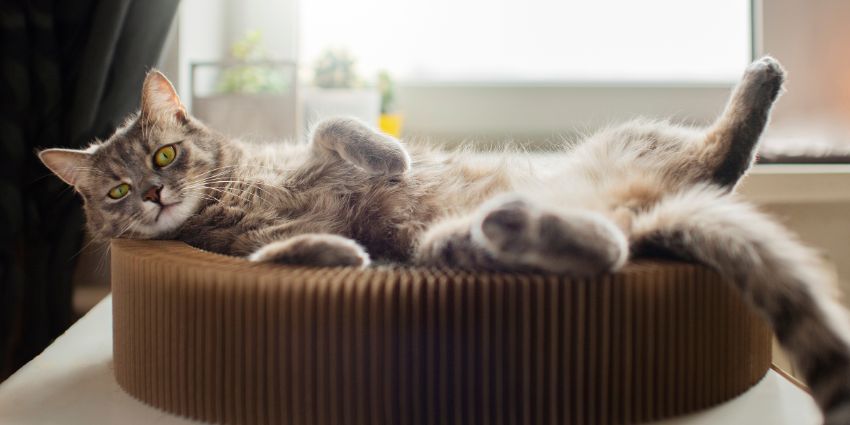Hey there! Welcome to our guide on teaching your cat to use the litter box. If you’re new to this or just need some help, don’t worry! We’re here to make it easy for you.
We’ll cover everything from choosing the right box to solving any problems that come up while you’re training your cat. Let’s get started on making your furry friend a litter box pro!

Before You Start: Gather Supplies
Before starting with the litter box training, make sure you have all the supplies you’ll need. The following are the essentials:
- Litter Box- Think of the litter box as your cat’s bathroom. It’s important to choose one that’s large enough for your cat to comfortably turn around in and deep enough to contain the litter. If your cat is older or has trouble moving around, find a litter box with low sides so they can get in and out more easily.
- Cat Litter- When you’re choosing cat litter, there are two main types: clumping and non-clumping. Each has good and bad points. Clumping litter forms solid clumps when wet, making it easier to scoop out waste daily, but some cats might eat it, which can be bad for them. Non-clumping litter absorbs urine but doesn’t form clumps. Some cats prefer the texture of this litter, but the downsides are that it might not control smells as well, and you have to change it more often. Experiment with different types to see which one your cat prefers.
- Litter Scoop- A litter scoop is very important when it comes to keeping the litter box clean and odor-free. It keeps your cat’s environment hygienic by removing waste and clumps easily. You should choose a strong scoop that has slots or holes that let you sift through the litter easily.
Choosing the Right Litter Box and Location
Choosing the perfect litter box and figuring out where to put it are important for helping your cat learn to use it properly.
As we mentioned before, you need to think about how big your cat is. You need a litter box that’s big enough for your cat to move around in comfortably. If you have more than one cat, it’s a good idea to have more than one litter box. This way, each cat has their own space and there’s less chance of them getting into fights or having accidents.
There are different kinds of litter boxes you can choose from. Some are open and simple, some are covered for privacy and to keep smells in, and some are automatic, which means they self-clean! Pick the one that works best for your cat and your daily routine.
Where you put the litter box is super important too. Find a quiet spot where your cat feels safe, away from their food and water bowls. Cats like to keep their bathroom separate from where they eat.
Step-by-Step Guidance on How to Train Your Cat to the Litter Box
Training your cat to use the litter box is a step-by-step process that requires patience and consistency. Here’s a simple guide to help you:
- Introduce the Litter Box- After putting the litter box in a quiet, accessible location, show it to your cat and let them explore it at their own pace. You can also put a tiny bit of catnip in the box to encourage them to check it out.
- Encourage Exploration- If your cat seems unsure about the litter box, you can gently lead them toward it with treats or toys. When they start showing interest, give them lots of praise. Don’t push them if they’re not ready.
- Positive Reinforcement- Every time your cat goes to the litter box properly, give them lots of praise and treats. This makes them feel good and want to keep using the litter box the right way.
- Monitor and Clean- Watch your cat closely when they go to the bathroom and clean the litter box right away. Cats like things to be clean, so keeping the litter box fresh will make them want to use it more.
- Address Accidents- If your cat has an accident outside the litter box, don’t get mad at them. Instead, clean up the mess thoroughly with an enzymatic cleaner to get rid of smells. This stops them from going to the same spot again.
- Be Patient- Litter box training takes time, so be patient and understanding with your cat. If they’re struggling or having accidents, don’t give up hope. Stay consistent with the training and continue giving positive reinforcement.
Maintaining Litter Box Hygiene
As we mentioned above, it’s really important to keep your cat’s litter box clean so they stay healthy and happy. If the litter box is dirty, your cat might not want to use it, and it could even lead to health problems. Here’s how to keep it clean:
Firstly, scoop the litter box every day, to get rid of the clumps and poop. This keeps the litter fresh and nice for your cat.
It’s important to regularly change the litter completely. How often you need to do this depends on the type of litter you use and how many cats you have. Some kinds of litter need to be changed more often than others. Also, clean the litter box with mild soap and water regularly. Don’t use strong cleaners because they might scare your cat away from using the box. Rinse the box well and let it dry completely before you put in new litter.
Watch out for any signs that your cat might not be feeling well, like if they’re not using the litter box or if they’re having trouble peeing. These signs could mean they have a urinary tract infection or another health problem, so it would be good to take them to the vet.
Special Considerations for Different Cats
Different cats have different needs when it comes to using the litter box. Whether you have a tiny kitten, a senior cat, or a cat transitioning from outdoors to indoors, there are some special things to keep in mind to help them learn to use the litter box, so let’s talk about them:
- Kittens- Kittens might need a little extra help learning to use the litter box. Start by showing them where it is and gently guiding them inside. They’ll learn pretty quickly, but accidents could happen along the way. Just be patient and keep showing them the right spot.
- Senior Cats- Older cats could have trouble getting in and out of the litter box, especially if it’s too high or has tall sides. Make sure the box is easy for them to climb into, and try placing it in a quiet, easily accessible spot. If your senior cat starts having accidents, it could be a sign of a health issue, so it’s a good idea to take it to the vet.
- Outdoor Cats Transitioning Indoors- Cats used to doing their business outside might need some time to adjust to using a litter box indoors. Start by providing a litter box with a similar texture to the ground outside, like sandy litter. You will also need to show them where the litter box is and encourage them to use it with treats. Gradually, they’ll get used to the new routine.
Frequently Asked Questions
1. When to start training a cat to use the litter box?
You can start training your cat to use the litter box as soon as you bring them home, whether they’re a kitten or an adult. Kittens usually learn quicker, but older cats can learn too!
2. How long does it take to litter train a cat?
Every cat is different, so it’s hard to say exactly how long it will take. Some cats figure it out in just a few days, while others might take more time, but if you follow the steps we mentioned, your cat could become good at using it within 4 to 6 weeks.
3. What to do if your cat won’t use the tray?
If your cat doesn’t like using the litter box, there could be a few reasons why. Make sure the litter box is always clean and in a quiet, easy-to-reach spot. You can also try using different types of litter or litter boxes to see what your cat likes best. If problems keep happening, it’s a good idea to talk to the vet to make sure there’s not a health issue causing the problem.
4. Are cats easy to litter box train?
Most of the time, yes! Cats are pretty clever animals, and they usually learn to use the litter box pretty fast. Just keep being patient and consistent with the training, and your cat will figure it out eventually.
5. Why punishment is a bad idea?
Punishing your cat for not using the litter box isn’t a good idea because it can make them scared or confused. Cats don’t understand punishment like humans do, so they won’t know why they’re being punished. Instead of punishing them, try using positive reinforcement, like treats and praise, to encourage them to use the litter box. This works much better and keeps your cat happy and stress-free!
Conclusion
Training your cat to use the litter box might seem tricky at first, but with patience and love, you can help them learn. Remember to choose the right litter box and keep it clean, especially for kittens, older cats, and cats transitioning from outdoors. Be patient if your cat has accidents, and never punish them – positive reinforcement works best.
With time and consistency, your cat will become a litter box pro, which will lead to a happier and healthier relationship between you and your furry friend! For more helpful tips on caring for your cat, check out our blog on Essential Cat Care Tips for Beginners!



